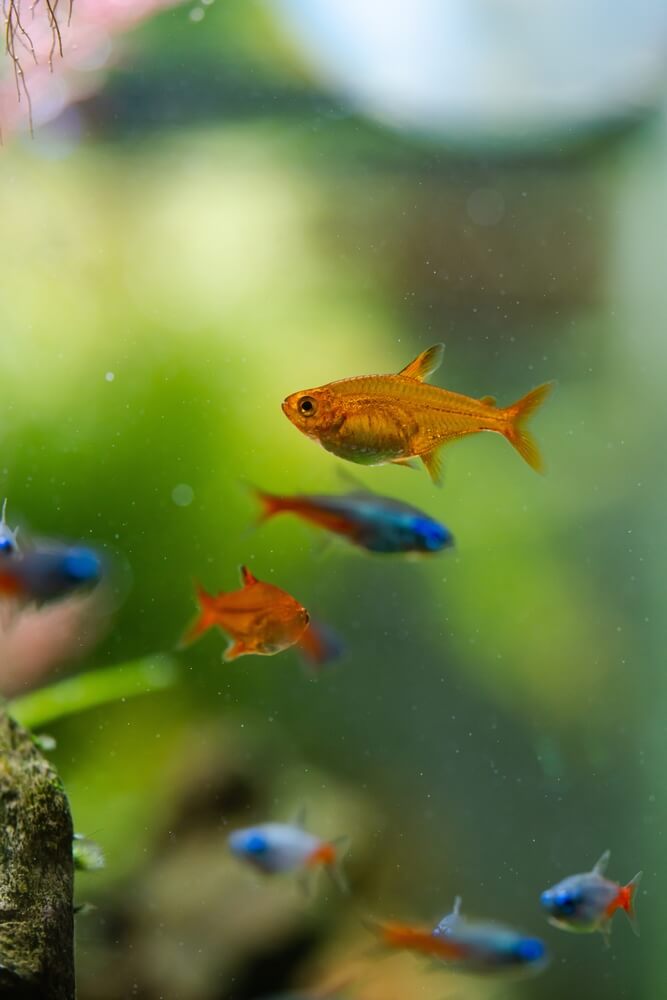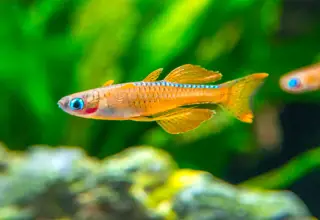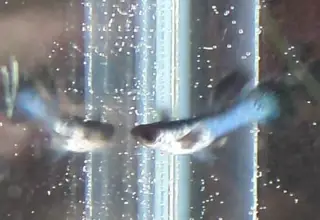Ember Tetra: Care, Size, Where to Purchase & More
Posted by on 11/22/2023
Whether you're the proud owner of a new nano-sized tank or are just looking for some small fish to add to your aquarium, the Ember Tetra is an excellent fish appreciated by both new and veteran hobbyists.
Relatively common, Ember Tetras are known for their laidback behavior and unique appearance. These fish have even landed on our list of 10 centerpiece fish for a 10-gallon tank. If you're considering the Ember Tetra as your next fish, we're going to cover everything you'll need to know about the species, including its diet, adult size, behavior, and much more.
January's Giveaways on Light Fish
Species Summary
The Ember Tetra (scientific name: Hyphessobrycon amandae) was first scientifically documented by German researcher Heiko Bleher. Heiko had made quite a few discoveries throughout his career, including the discovery of both aquatic and terrestrial plants, as well as different species of fish. His discoveries spanned the world, from the Congo River basin to the islands of Indonesia. However, his most popular is without a doubt the Ember Tetra.
This small fish, native to the Araguaia River in Brazil, is a member of the Characidae family, whose descendants include other popular aquarium fish, such as the Neon Tetra and Emperor Tetra, both of which share a similar appearance to the Ember.

Appearance
Ember tetras tend to "color up", a feature we see in other tetras, such as the Green Neon Tetra. As the sun rises, or when the aquarium lights turn on, these fish will transform from a translucent coloration into a bright orange color.
The Ember Tetra has a torpedo-shaped body, which is slightly translucent. The entire fish is orange, except its black eye, which sits along the side of the fish's head. The fins of the fish show orange coloration and transition to a transparent color along the edge of the fins.
Size
The Ember Tetra is a small fish, and adults will only grow to be about 0.8 inches in length.
Feeding your Ember Tetra a nutrient-rich diet, combined with a pristine environment, will ensure it reaches a healthy adult size.
Male vs Female
You'll need to closely examine your Ember Tetra to determine whether it's male or female.
Female Ember tetras tend to have round-shaped bodies, while males tend to be a bit more streamlined. Males may even show a brighter coloration when courting potential females.

Ember Tetra Care
Luckily for beginners, Ember Tetras are some of the easiest fish to care for. They're relatively undemanding and can adapt to most conditions.
Still, as with all fish you choose to keep, you'll want to care for them as best as possible. To do so, we'll want to recreate their native environment as closely as possible.
🛒 Shop Freshwater Fish on Light Fish
Lifespan
Ember Tetras kept in captivity can live for up to 6 years.
When provided a pristine environment and a well-balanced diet, there have even been reports of these fish living for up to 10 years!
Tank Size
Ember Tetras require a tank that's at least 10 gallons in size.
Due to their small size, they make excellent fish for a planted nano tank, but don't be afraid to go even bigger! A large school of these fish can be kept in a larger tank, aim for 5 ember tetras for every 10 gallons.
Acclimation
When possible, it's always best to drip acclimate new tank additions. Using a drip acclimation kit is a surefire way to ensure your fish have all the time they need to adapt to their new water conditions.
Luckily, Ember Tetras are a relatively hardy fish, and if you don't have a drip acclimation kit, you can float the transport bag in your tank. You'll want to cut open the transport bag, and slowly add a bit of tank water into the bag every 20 minutes. After an hour has passed, you can release the fish directly into your tank. Following either drip acclimation or the bag-float method, will allow your fish to adjust to your aquarium's temperature and water conditions.
Water Conditions
Ember Tetras hail from the eastern waterways of the Amazon, where water conditions tend to be slightly acidic. Luckily, these fish are capable of adapting to hard water conditions, given proper acclimation time.
As a rule of thumb, you'll want to aim for the following water parameters:
Temperature Range: 76°F-80°F
KH: 4-8 dKH
pH: 6.5-7.2
Maintaining these parameters, when combined with 40% weekly water changes, will set you up for success in caring for the Ember Tetra.
Tank Setup
Ember Tetras will thrive in an aquarium with a heater, some form of mild current, and live aquatic plants. The aquarium should be fully established, and temperatures should be set to 76-80°F
Live plant options could include Anubias Frazeri, Taiwan Lilies, or Rotala H'ra. Hardscape options, such as driftwood - including cholla wood, mopani wood, and Malaysian will all make great additions to an ember tetra tank. Seiryu stones can be used with caution, but keep in mind these stones do raise pH levels over time.
When possible, we recommend a tight-fitting lid, as these fish have been known to jump out of tanks when spooked (from vibrations such as a door slamming, etc.)
Avoid fake aquatic plants, as the plastic can easily cut through an Ember Tetra's delicate fins.
Common Diseases
Ember Tetras are susceptible to many of the common diseases that affect freshwater aquarium fish. Some of the most common include fin rot, epistylis, and ich.
The number one culprit for these diseases tends to be poor water quality. Performing weekly 30% water changes and providing live aquatic plants will keep your aquarium water pristine.
If you're treating affected fish, over-the-counter solutions such as Ich-X can be used, but in most cases, providing your fish with a well-balanced diet, and performing regular water changes will nurse them back to full health.
Food & Diet
Ember Tetras should be fed a diet consisting of nutrient-rich flake food 1-2 times per day.
As a treat, you can supplement their diet with either live or frozen bloodworms.
Behavior and Temperament
Ember Tetras are known for their laid-back personalities. These fish are peaceful and tend to hover in place, occasionally swimming back and forth throughout the tank. They make for excellent schooling fish, and are frequently kept in groups of 20 or more in larger aquascapes. We find them to be a bit less active when compared to other tetra fish, such as the Blue Emperor Tetra.
Tank Mates
Due to their peaceful temperament, hobbyists will have a wide variety of tank mates to choose from.
Some suitable tank mates for the Ember Tetra include:
You'll want to avoid aggressive fish, such as the electric blue jack dempsey, snow white cichlid, or the red dragon flowerhorn.

Breeding
Luckily for breeders, ember tetras have been successfully bred in captivity. You'll want to set up an established, fully-cycled, breeder tank so that you can successfully raise the fry after the eggs have been laid. Once the breeder tank is established with a heater and plenty of hiding spots, you can introduce a group of male and female ember tetras.
Keep an eye on the fish and look out for any eggs - Embers may even view their eggs as a potential snack! After a day has passed, the eggs will hatch, and the fry will emerge. This is the most difficult step in breeding - raising the fry.
You'll need to perform semi-daily 10% water changes, reduce lighting, and feed the fry with microfauna, such as Baby Brine Shrimp, Microworms, and Daphnia 2-3 times per day. You'll also want to reduce the lighting period. Maintain this schedule over a few months. If done successfully, you'll have successfully bred Ember Tetras!
🛒 Shop Aquarium Plants Fish on Light Fish
Where to Purchase
Hobbyists should consider our marketplace, where they can purchase directly from other hobbyists online. It's also worth phoning up your local fish store, as these fish are relatively common and may be in stock.
If you're still having trouble finding Ember Tetras for sale, we built a massive list of over 250+ online aquarium stores, that you can use to find aquarium shops throughout the United States.
Conclusion
That wraps up our care guide on Ember Tetras. Now that you've learned all about this unique fish, do you plan on adding a few to your tank? We guarantee you'll love all these fish have to offer.
Let us know if you have experience keeping Ember Tetras in the comments below, and be sure to check out our marketplace, where you can buy and sell directly with other aquarium hobbyists.
January's Giveaways on Light Fish














